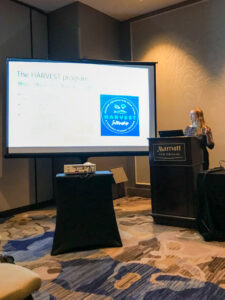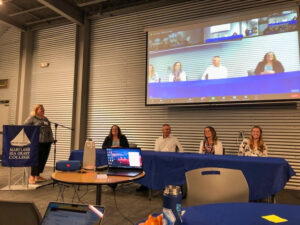
Hayley Lemoine presenting at 2023 Aquaculture America conference. Image courtesy of Hayley Lemoine.
This blog is part of a series called AquaCurious, which discusses important and popular topics related to finfish aquaculture in the U.S.
This past February, over a thousand people from all across the U.S. convened in New Orleans for the Aquaculture America conference, including regulators, developers, communicators, scientists, policy-makers, business owners, students, and farmers.
This annual conference offers an opportunity to discuss the future of American aquaculture, and to learn about different perspectives regarding what it should and should not entail. This year, offshore aquaculture – or “open ocean” aquaculture- received notable attention. Offshore aquaculture is a relatively nascent form of aquatic farming; in the U.S. it’s virtually nonexistent, with only one farm operating in state waters and zero in federal waters.
While there is no scientific consensus on the exact criteria that determine if a farm is offshore or not, it is generally accepted that offshore aquaculture requires deep waters and high currents, which usually means exposed, high-energy environments.
As a result, offshore aquaculture occurs in an environment that is very different from any other type of farming and therefore faces a unique set of challenges and considerations.
There are currently no offshore farms in U.S. federal waters, but a couple of pilot projects, including Aquafort and Vellela Epsilon, have cropped up in recent years, as offshore aquaculture development has gained traction with decision-makers and developers. For example, in May 2020, the White House issued an executive order promoting offshore aquaculture development in the U.S.
On the first full day of the conference, I attended a panel discussion on offshore aquaculture with representatives from NOAA’s Office of Aquaculture, Environmental Defense Fund, Hubbs-SeaWorld Research Institute, Zeigler Bros, Inc., and Ocean Era, Inc. The panelists discussed the state of offshore aquaculture policy and opportunities for building consensus, including gaps in our knowledge that need to be addressed as this industry moves forward.
This annual conference offers an opportunity to discuss the future of American aquaculture, and to learn about different perspectives regarding what it should and should not entail.
Hayley Lemoine
 Knowledge Gaps
Knowledge Gaps
Central to the panel discussion was the need to address current knowledge gaps to ensure sustainable development of the offshore aquaculture industry in the U.S. Danielle Blacklock, Director of NOAA’s Office of Aquaculture, described these knowledge gaps as “opportunities for advancement,” which fell broadly into three categories.
1. Streamlining governance
Since offshore aquaculture is a new industry in the U.S., there is not an established regulatory system designed with offshore aquaculture in mind, so there is no clear government agency in charge. Also, offshore farms will often need access to both state and federal waters as well as coastal land infrastructure, so there are numerous government agencies needed to permit and manage it. An important opportunity for advancement lies in the specifics of how to effectively and efficiently govern this industry.
One question that stood out to me is how policy can be leveraged to build equity and inclusion in this industry. For example, government-sponsored training programs (i.e., Aquaculture in Shared Waters) can offset some of the burdens (e.g., cost, expertise) that might otherwise prohibit entry into aquaculture. Another consideration is the specifics of offshore aquaculture employment opportunities, including whether they will require academic degrees or other specialized training and which communities will likely benefit from these jobs. While investment in the working waterfront, including the creation of jobs, is regularly touted as a key benefit to expanding aquaculture, it is unclear if and how policy can ensure that local communities and working waterfronts benefit directly from the expansion of offshore aquaculture.
2. Planning for sociocultural impacts
There is a dearth of data on the sociocultural impacts of aquaculture, including what effects offshore aquaculture development will have on the coastal communities most likely to be directly affected by the development and expansion of this industry. These effects could include substantial changes to community demographics, employment options, coastal infrastructure, waterfront access, seafood cost, access or availability, and disruptions to cultural norms, to name a few.
Part of the challenge with addressing sociocultural impacts is the place-specific nature of these considerations. Understanding local-scale concerns and potential impacts requires resource-intensive data generation efforts and nuanced policies that can be challenging to apply broadly across communities. The collection of social data to better plan for sociocultural impacts is therefore an opportunity to advance understanding of the impacts of offshore aquaculture development.
3. Improving messaging and addressing misinformation
As the panel drew to a close, experts spoke about the necessity of enhancing public understanding of aquaculture, namely by addressing misinformation and improving messaging. It is widely acknowledged that aquaculture’s social license to operate, similar to public approval, is limited.
The panel acknowledged that some stakeholders have been vocal about their concerns (e.g., environmental degradation), which underscores the importance of working closely with communities to ensure they are receiving accurate information and know where to inquire for up-to-date responses to any questions they may have. The panel talked about the responsibility of every organization, business, and agency to provide truthful and scientifically accurate information about what we know, what we don’t know, and what efforts are being taken to address concerns and knowledge gaps.
Final Thoughts
The Aquaculture America conference left me with the undeniable impression that there is a long road ahead if a domestic offshore aquaculture industry is to gain a solid foothold in American seafood. At the same time, offshore aquaculture has also come a long way since its inception less than fifty years ago. For instance, substantially smaller amounts of wild fish are being used in finfish aquaculture than in the early days of this industry. It is easy to look backward at our mistakes and forward towards everything we don’t yet know, but we must also not lose sight of all the issues that have already been resolved, and the impressive amount of collaboration, support, and human ingenuity that is taking place right now, expanding the bounds of what is possible.